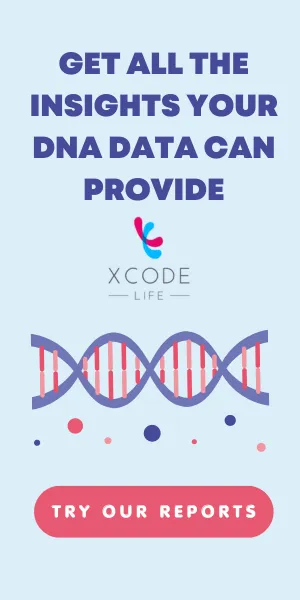CYP1B1 Gene – An Introduction
The CYP1B1 enzyme is a part of the Cytochrome P450 (CYPs) family and was first identified in 1994. The CYP family is a group of enzymes that play a major role in detoxification in the body.
This enzyme helps in the metabolism and clearance of the various endogenous (produced internally) and exogenous (produced externally) substances.
It is especially important for metabolizing cancer-causing agents (procarcinogens) like 17 beta-estradiol (an estrogen hormone) and Polycyclic Aromatic Hydrocarbons (PAHs). This enzyme is also responsible for adding oxygen atoms to other molecules.
This enzyme is produced in many tissues in the body, including the eyes. The CYP1B1 gene controls the production of the CYP1B1 enzyme. Certain changes (or mutations) in this gene can lead to overproduction or insufficient production of the enzyme and lead to diseases like primary congenital glaucoma.
Substances that the CYP1B1 gene act on
Fatty Acids and Fat-soluble Vitamins
The CYP1B1 enzyme helps in processing polyunsaturated fatty acids and fat-soluble vitamins like vitamins A, D, E, and K.
Steroidal Hormones (like Estrogen)
The CYP1B1 enzyme is the most important enzyme required for 17 beta-estradiol (E2) metabolism. Metabolism is the process by which large and complex food molecules and medicines are broken down into smaller components to produce energy, build or repair body tissues, produce hormones, and do more such activities needed for the body. This hormone is responsible for the female reproductive system management. High levels of E2 in the body can increase the risk for breast, ovarian, and uterine cancer.
Melatonin
Melatonin is a natural hormone found in the human body. Melatonin is secreted at night by the pineal glands and controls the sleep-wake cycle. Recent studies have identified that melatonin kills certain types of cancer cells in the body – melatonin has anti-cancer properties. The CYP1B1 enzyme helps in the transformation of melatonin into N-acetylserotonin (NAS). NAS helps destroy cancer cells.
Polycyclic Aromatic Hydrocarbons (PAHs)
PAHs are chemicals commonly found in certain natural sources like fossil fuels and many man-made products like toiletries, tobacco, garbage, and different plastic and rubber products. PAH is also produced when meat and other kinds of food are cooked at high temperatures and charred. PAHs are air-bound and enter the body when people breathe.
Both the CYP1A1 and the CYP1B1 enzymes help convert PAHs into a more active form in the phase 1 detoxification stage. With more exposure to PAHs, the body produces more CYP1B1 enzymes, and more free radicals are produced. This increases the risk of cancers.
CYP1B1 Inducers and Inhibitors
Inducers are substances that increase the metabolic activity of the enzyme. Inhibitors are substances that bind to the enzyme to reduce its activity.
Drugs That induce CYP1B1 activity
- Docetaxel – Docetaxel is a chemotherapy medication that is used in the treatment of different types of cancers.
- 2,3,7,8-Tetrachlorodibenzo-p-dioxin (TCDD) – TCDD is an organic pollutant produced as a byproduct in herbicide manufacture.
Drugs That Inhibit CYP1B1 activity
There are many drugs that inhibit CYP1B1 activity. Some of them are:
- Stilbene – A low-molecular compound that is available in both natural and artificial forms. Natural stilbenes are types of plant nutrients. Artificial stilbenes are used in making synthetic estrogens and making dye lasers.
- Tetramethoxystilbene (TMS) – TMS is a type of plant compound that helps with cell growth. TMS shows a 50-fold higher inhibition rate for the CYP1B1 enzyme when compared to the CYP1A1 enzyme.
- Coumarin – Coumarin is a natural chemical that has a bitter taste and the smell of vanilla. This chemical is found in a lot of plants and acts as a defense against predators. Coumarin is present in tonka bean, cassia cinnamon, strawberries, cherries, apricots, and blackcurrants.
- Anthraquinone – Anthraquinone is a yellow-colored organic compound that is commonly used in making dyes and for paper.
- Flavonoids – Flavonoids are plant pigments that are important antioxidants.
- Oltipraz – Oltipraz is a drug that helps prevent cancer.
Variations in the CYP1B1 gene
CYP1B1 enzymes, produced by the CYP1B1 gene, protect the body from oxidative stress. Oxidative stress is caused due to increased free radicals in the body, resulting in cell damage. Changes in the CYP1B1 gene can decrease or increase the levels of the CYP1B1 enzyme produced.
- Changes in this gene are associated with glaucoma – an eye disease that causes nerve damage in the eyes and leads to blindness.
- Increased production of the CYP1B1 enzyme causes obesity, high blood pressure, and glucose intolerance.
- Changes in the CYP1B1 gene also lead to an increased risk of different types of cancers, including breast, ovarian, uterine, renal, and non-small lung cancer.
| Haplotype | Effect | Implications |
| CYP1B1*2 | Increased enzyme activity | Increased risk of oxidative stress and different types of cancer |
| CYP1B1*3 | Increased enzyme activity | Increased risk of oxidative stress and different types of cancer |
| CYP1B1*4 | Increased enzyme activity | Increased risk of oxidative stress and different types of cancer |
| CYP1B1*12 | Decreased enzyme activity | Lowered risk of oxidative stress and different types of cancer |
A haplotype is a group of gene changes that are inherited together. The *2, *3, *4, and *12 are star alleles. Star alleles are used to name different haplotypes.
Recommendations to Boost CYP1B1 Metabolism
Foods that Support CYP1B1 Enzyme Activity
- Berries
- Seafood
- Dark chocolate
- Nuts and seeds
- Kale
- Artichokes
- Spinach
Certain foods can encourage high levels of estrogen production in the body. To process high estrogen levels, the body produces an excess of the CYP1B1 enzyme.
This can lead to a high risk for different types of cancers, including breast cancer, ovarian cancer, and uterine cancer.
The foods listed below can naturally bring down estrogen metabolism in the body.
- Cruciferous vegetables like broccoli, cauliflower, Brussels sprout, cabbage
- Fiber-rich fruits and vegetables
- Whole grains
- Flax seeds
- Tomatoes
- Cheese
Quit smoking
Cigarettes contain multiple Polycyclic Aromatic Hydrocarbons (PAHs) and various other chemicals. Smoking encourages PAH-DNA adduct formation in the lungs. PAH-DNA adduct is the accumulation of genetic changes in the DNA cells, leading to the formation of cancerous cells.
In a 2000 study, the relationship between CYP1B1 enzyme, regular smoking, and PAH-DNA adduct formation was examined. The CYP1B1 enzyme metabolizes PAHs. The study reported that people who smoked had more risk for increased PAH-DNA adduct formation and hence had higher chances of developing lung and other types of cancers.
Reduce Exposure to UV Radiation
According to certain studies, over-exposure to UV-B rays encourages the excess production of the CYP1B1 enzyme. This is one of the top causes of non-melanoma skin cancers.
Genetic Testing
Genetic testing can tell you if you are at a higher risk for excess production of CYP1B1 enzyme in the body. If so, you may be asked to get yourself screened for different types of cancers. Genetic testing will help diagnose cancers and other health conditions because of CYP1B1 gene mutations early and improve the success rate of treatments.
Summary
- The CYP1B1 gene helps produce the CYP1B1 enzyme. This enzyme helps eliminate various toxins, drugs, and chemicals from the body.
- The enzyme is regulated by the aryl hydrocarbon receptor (AHR) in the body.
- The CYP1B1 enzyme helps transform fatty acids, fat-soluble vitamins, melatonin, estrogen, and PAHs from the body.
- Changes in this gene can cause overactivity of the CYP1B1 enzyme and increase the risk of oxidative stress, glaucoma, and different types of cancers.
- The *2, *3, and *4 alleles of the CYP1B1 gene increase the enzyme activity, while the *12 allele decreases the enzyme activity.
- Quitting smoking, consuming antioxidant-rich foods, reducing UV exposure, and preventing estrogen-increasing foods all help normalize CYP1B1 enzyme activity.
- Genetic testing can help identify your CYP1B1 enzyme activity. If you happen to have higher levels of the enzyme, regular cancer screening is recommended.
References
- https://en.wikipedia.org/wiki/CYP1B1
- https://medlineplus.gov/genetics/gene/cyp1b1/#conditions
- https://bmccancer.biomedcentral.com/articles/10.1186/1471-2407-10-420
- https://www.snpedia.com/index.php/Rs1800440
- https://pubmed.ncbi.nlm.nih.gov/29574860/
- https://www.medicalnewstoday.com/articles/323280#treatments
- https://selfhacked.com/blog/cyp-enzymes-interact-supplements-related-genes/
- https://pubmed.ncbi.nlm.nih.gov/20696580/
- https://www.ncbi.nlm.nih.gov/pmc/articles/PMC4455350/




